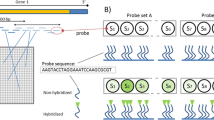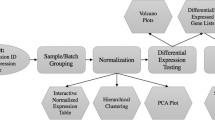Abstract
Microarrays offer a powerful approach to the analysis of gene expression that can be used for a wide variety of experimental purposes. However, there are several types of microarray platforms that are available. In addition, microarray experiments are expensive and generate complicated data sets that can be difficult to interpret. Success with microarray approaches requires a sound experimental design and a coordinated and appropriate use of statistical tools. Here, the advantages and pitfalls of utilizing microarrays are discussed, as are practical strategies to help novice users succeed with this method that can empower them with the ability to assay changes in gene expression at the whole genome level.
Similar content being viewed by others
References
Benito, M., Parker, J., Du, Q., Wu, J., Xiang, D., Perou, C. M., & Marron, J. S. (2004). Adjustment of systematic microarray data biases. Bioinformatics, 20, 105–114.
Calin, G. A., Dumitru, C. D., Shimizu, M., Bichi, R., Zupo, S., Noch, E., Aldler, H., Rattan, S., Keating, M., Rai, K., Rassenti, L., Kipps, T., Negrini, M., Bullrich, F, & Croce, C. M. (2002). Frequent deletions and down-regulation of micro- RNA genes miR15 and miR16 at 13q14 in chronic lymphocytic leukemia. Proceedings of the National Academy of Sciences of the United States of America, 99, 15524–15529.
Ferrando, A. A., Neuberg, D. S., Staunton, J., Loh, M. L., Huard, C., Raimondi, S. C., Behm, F. G., Pui, C. H., Downing, J. R., Gilliland, D. G., Lander, E. S., Golub, T. R., Look, A. T. (2002). Gene expression signatures define novel oncogenic pathways in T cell acute lymphoblastic leukemia. Cancer Cell, 1, 75–87.
Frueh, F. W., Hayashibara, K. C., Brown, P. O., & Whitlock, J. P. J. (2001) Use of cDNA microarrays to analyze dioxin-induced changes in human liver gene expression. Toxicology Letters, 122, 189–203.
Helman, P., Veroff, R., Atlas, S. R., & Willman, C. (2004) A Bayesian network classification methodology for gene expression data. Journal of Computational Biology, 11(4), 581–615.
Iorio, M. V., Ferracin, M., Liu, C. G., Veronese, A., Spizzo, R., Sabbioni, S., Magri, E., Pedriali, M., Fabbri, M., Campiglio, M., Menard, S., Palazzo, J. P., Rosenberg, A., Musiani, P., Volinia, S., Nenci, I., Calin, G. A., Querzoli, P., Negrini, M, & Croce, C. M. (2005). MicroRNA gene expression deregulation in human breast cancer. Cancer Research, 65, 7065–7070.
Ishida, N., Hara, T., Kamura, T., Yoshida, M., Nakayama, K, & Nakayama, K. I. (2002). Phosphorylation of p27Kip1 on serine 10 is required for its binding to CRM1 and nuclear export. Journal of Biological Chemistry, 277, 14355–14358.
Karyala, S., Guo, J., Sartor, M., Medvedovic, M., Kann, S., Puga, A., Ryan, P, Tomlinson, C. R. (2004). Different global gene expression profiles in benzo[a]pyrene- and dioxin-treated vascular smooth muscle cells of AHR-knockout and wild-type mice. Cardiovascular and Toxicology, 4, 47–73.
Lei, W., Rushton, J. J., Davis, L. M., Liu, F, Ness, S. A. (2004). Positive and negative determinants of target gene specificity in Myb transcription factors. Journal of Biological Chemistry, 279, 29519–29527.
Liang, G., Gonzales, F. A., Jones, P. A., Orntoft, T. F., & Thykjaer, T. (2002). Analysis of gene induction in human fibroblasts and bladder cancer cells exposed to the methylation inhibitor 5-aza-2′-deoxycytidine. Cancer Research, 62, 961–966.
Liu, F., Lei, W., O’Rourke, J. P., & Ness, S. A. (2006). Oncogenic mutations cause dramatic, qualitative changes in the transcriptional activity of c-Myb. Oncogene, 25, 795–805.
Monks, A., Harris, E., Hose, C., Connelly, J., & Sausville, E. A. (2003). Genotoxic profiling of MCF-7 breast cancer cell line elucidates gene expression modifications underlying toxicity of the anticancer drug 2-(4-amino-3-methylphenyl)-5-fluorobenzothiazole. Molecular Pharmacology, 63, 766–772.
Pan, Q., Saltzman, A. L., Kim, Y. K., Misquitta, C., Shai, O., Maquat, L. E., Frey, B. J., & Blencowe, B. J. (2006). Quantitative microarray profiling provides evidence against widespread coupling of alternative splicing with nonsense-mediated mRNA decay to control gene expression. Genes & Development, 20, 153–158.
Pan, Q., Shai, O., Misquitta, C., Zhang, W., Saltzman, A. L., Mohammad, N., Babak, T., Siu, H., Hughes, T. R., Morris, Q. D., Frey, B. J., & Blencowe, B. J. (2004). Revealing global regulatory features of mammalian alternative splicing using a quantitative microarray platform. Molecular Cell, 16, 929–941.
Rushton, J. J., Davis, L. M., Lei, W., Mo, X., Leutz, A, & Ness, S. A. (2003). Distinct changes in gene expression induced by A-Myb, B-Myb and c-Myb proteins. Oncogene, 22, 308–313.
Segal, M. R., Dahlquist, K. D., & Conklin, B. R. (2003). Regression approaches for microarray data analysis. Journal of Computational Biology, 10, 961–980.
Sotiriou, C., Neo, S. Y., McShane, L. M., Korn, E. L., Long, P. M., Jazaeri, A., Martiat, P., Fox, S. B., Harris, A. L., & Liu, E. T. (2003). Breast cancer classification and prognosis based on gene expression profiles from a population-based study. Proceedings of the National Academy of Sciences of the United States of America, 100, 10393–10398.
Spellman, P. T., Sherlock, G., Zhang, M. Q., Iyer, V. R., Anders, K., Eisen, M. B., Brown, P. O., Botstein, D., & Futcher, B. (1998). Comprehensive identification of cell cycle-regulated genes of the yeast Saccharomyces cerevisiae by microarray hybridization. Molecular Biology of the Cell, 9, 3273–3297.
Teh, M. T., Blaydon, D., Chaplin, T., Foot, N. J., Skoulakis, S., Raghavan, M., Harwood, C. A., Proby, C. M., Philpott, M. P., Young, B. D., & Kelsell, D. P. (2005). Genomewide single nucleotide polymorphism microarray mapping in basal cell carcinomas unveils uniparental disomy as a key somatic event. Cancer Research, 65, 8597–8603.
Valk, P. J., Verhaak, R. G., Beijen, M. A., Erpelinck, C. A., Barjesteh van Waalwijk van Doorn-Khosrovani, S., Boer, J. M., Beverloo, H. B., Moorhouse, M. J., van der Spek, P. J., Lowenberg, B., & Delwel, R. (2004). Prognostically useful gene-expression profiles in acute myeloid leukemia. New England Journal of Medicine, 350, 1617–1628.
Verheyen, G. R., Nuijten, J. M., Van Hummelen, P., & Schoeters, G. R. (2004). Microarray analysis of the effect of diesel exhaust particles on in␣vitro cultured macrophages. Toxicology In Vitro, 18, 377–391.
Wilson, C. S., Davidson, G. S., Martin, S. B., Andries, E., Potter, J., Harvey, R., Ar, K., Xu, Y., Kopecky, K. J., Ankerst, D. P., Gundacker, H., Slovak, M. L., Mosquera-Caro, M., Chen, I. M., Stirewalt, D. L., Murphy, M., Schultz, F. A., Kang, H., Wang, X., Radich, J. P., Appelbaum, F. R., Atlas, S. R., Godwin, J., & Willman, C. L. (2006). Gene expression profiling of adult acute myeloid leukemia identifies novel biologic clusters for risk classification and outcome prediction. Blood, 108, 685–696.
Yang, H. C., Liang, Y. J., Huang, M. C., Li, L. H., Lin, C. H., Wu, J. Y., Chen, Y. T., & Fann, C. S. (2006). A genome-wide study of preferential amplification/hybridization in microarray-based pooled DNA experiments. Nucleic Acids Research, 34, e106.
Acknowledgments
S.A.N. is supported by grants from the USPHS/National Cancer Institute (#RO1 CA058443 and #R01 CA105257) and by institutional support from the University of New Mexico Health Sciences Center and is Director of the Keck-UNM Genomics Resource, a microarray and gene expression analysis facility supported by a grant from the W.M. Keck Foundation as well as the State of New Mexico and the UNM Cancer Research and Treatment Center. The author thanks Dr. Gavin G. Pickett for helpful discussions and comments on the manuscript.
Author information
Authors and Affiliations
Corresponding author
Rights and permissions
About this article
Cite this article
Ness, S.A. Microarray analysis: basic strategies for successful experiments. Mol Biotechnol 36, 205–219 (2007). https://doi.org/10.1007/s12033-007-0012-6
Published:
Issue Date:
DOI: https://doi.org/10.1007/s12033-007-0012-6




